Love is in Savannah
Savannah, Georgia has been recognized as the most romantic city of the South (Huffington Post), and the fourth most romantic city in the United States (USA Today). Its historic atmosphere, its small city charm and its closeness to the river lure in visitors and locals alike. It takes you back in time around its historic buildings through its cobblestone streets in its horse-drawn carriages under the Spanish moss trees. It’s no wonder that so many people decide to get married in Savannah, making it one of the top 10 locations in the United States for destination weddings (American Profile).
On the other hand, Savannah also has an overall crime rate that is 27% higher than the normal average and was even named 7th on the list of worst possible cities to live in. Throughout this research project we want to understand the complicated culture of sustaining love in the specific setting offered in Savannah. We hope to discover how, and if, the love culture infiltrates the environment, the restaurants, the river and the squares of the city.
Ethnography
- A branch of anthropology that studies and describes individual human cultures.
- A way to gain an understanding of the every day realities of people working within diverse settings. -Bloomberg, Giacomi, Mosher & Swenton Wall (1991).
Contextual Research
- Context > The circumstances in which an event occurs; a setting.
- Research > Careful study of a given subject, field, or problem, undertaken to discover facts or principles.
Secondary Research
General Brainstorming
This brainstorming exercise was the first one we did in our first group meeting. The idea behind this method was to get a general idea of the concepts and topics each of us understood to be part of our future research.
Insights: This exercise allowed us to see how each of us understood the project. It also provided a simple way to start to get to know each other as a group. The final product offered us a list of topics we would use to continue our secondary research.
Deeper Brainstorming
After the initial brainstorming, we were asked in class to come up with more than 200 possible stakeholders. Although the task proved to be hard, we were able to come up with more than 250. This provided us with a deeper understanding of the topic and the many other concepts that surrounded it.
Insights: This exercise in particular guided us to look more into the feeling of love and less into the city, as the previous one had been guided to. We gathered themes for deeper analysis and possibilities to later integrate into our concept.
Buzz Reports
Through the constant share of information in Google Docs and iMessage, we began to define topics relevant to falling in love in Savannah such as: biology and love, the “dark side of love” and technologies of love.
Insights: We discovered different approaches of love through different team members’ perspectives, experiences and interests. Al these documents and links were shared by topic and allowed us to create a central index of information.
Popular Media Scan
We used brainstorming to discover keywords related to romance, emotions, love and Savannah. We later used these terms to get a deeper understanding through popular media scans.
Insights: It gave us a way to approach the vast information about falling in love and romance in Savannah. We were able to build a library of findings in a way that could help us identify patterns of topics.
Offering - Activity - Culture Map
The offering Activity Culture Map provided us with a different method to understand the relationships between the different topic and the central one. Starting with ‘Love’ in the center, we began to look for activities that were related and the concepts, places or objects related to those activities particularly.
Insights: The map led us relate many of the concepts we had from our brainstorming. Through it we were also able to get specific places, activities and behaviors that could be studied to get better insights. The most important questions that came out of these methods related to the exact moment of falling in love. What surrounds the action of falling in love? Is falling in love an action that only happens once? Or should we consider small everyday actions in a relationship as falling in love too?” In a relationship, each person falls in love for the first time in different moments.
Innovation Evolution Map


Through the Innovation evolution Map, we started to study the development of dating through history, the expectations and the different ways of meeting new people. We realized the importance of figuring out the preferences of the people in Savannah.
Insights: The map led us to understand the importance of finding ways and spaces to meet new people. We discovered that the need to meet people virtually came before the development of social media. We were also able to identify that many virtual approaches and innovations have been driven by our need to meet people, communicate with them (close and far) and our need for physical contact.
Primary Research
The information gathered through secondary research serves as the base for the next step: primary research. This process requires direct interaction with out particular setting and/or user in many different possible ways. This direct interaction will provide the most important data for our investigation and should cover all the different areas or topics of interest.Our primary research was comprised of:
- A cultural probe
- Field Trip
- Survey
- Observations
- Interviews
Cultural Probe Activity
A cultural probe serves as a form of installation or activity that allows a researcher to gather hard data. When faced when the challenge to design a cultural probe for the Friday Art March we went back and took a look at our secondary research and where we wanted to go from there. We determined that it was important for us to identify where people think love is and in which way they meet other people.
We redesigned our boards based on the insights we got from our prototype. We communicated with the owner from a store nearby, who welcomed us to set our probe in front of her art supply store. We included different elements as part of our probe. First, we had the boards with the questions, the labels, and the chocolates and bracelets as thank you offerings. Apart from this, we gave out a red frame with a heart cutout that had inscribed “#LoveIsHereSAV” and asked people to take pictures of what they thought love was and upload it to any social media using that hashtag.
The information gathered allowed us to understand more about our users. Meetings in person resulted higher than online meetings in a similar percent as in the prototype. The additional information related to the distribution of those in person meetings helped us generate a much clearer profile of our participants. For example:
- 64% of people in Savannah meet new people in person and 36% online.
- Most common in person meeting occur in School, Friends in common, and Bars.
- Most common online meetings happen with Facebook, Instagram and Tinder.
Field Trip / Painting with a Twist
Field visits allow researchers to spend time with people engaged in real-world activities were they can have conversations and focus on observations. As a field visit we decided to go to ‘Paint with a Twist’, an activity were couples go to drink and share while painting.
Insights: The visit gave us the opportunity to feel the environment, perceive the different attitudes between couples and meet new people. A lot of these couples became contacts for further interviews.
Survey
As a way to get specific data on the people that travel this city, we decided to ask some simple questions. We wanted to find out if they lived in Savannah, if they were visiting, why, or if they were in relationships. We surveyed some locals and tourists. It was interesting to see that 80% of tourists that we interviewed said they were visiting Savannah for romance.
Discoveries
- 80% of the tourists we surveyed said that came to Savannah for love. All of them where in a relationship.
- Half of the people who were from Savannah and were in a relationship, met here.
Interviews
Finally, we decided to approach directly couples, photographers, professors and a tour guide to have their personal insight guide our research.






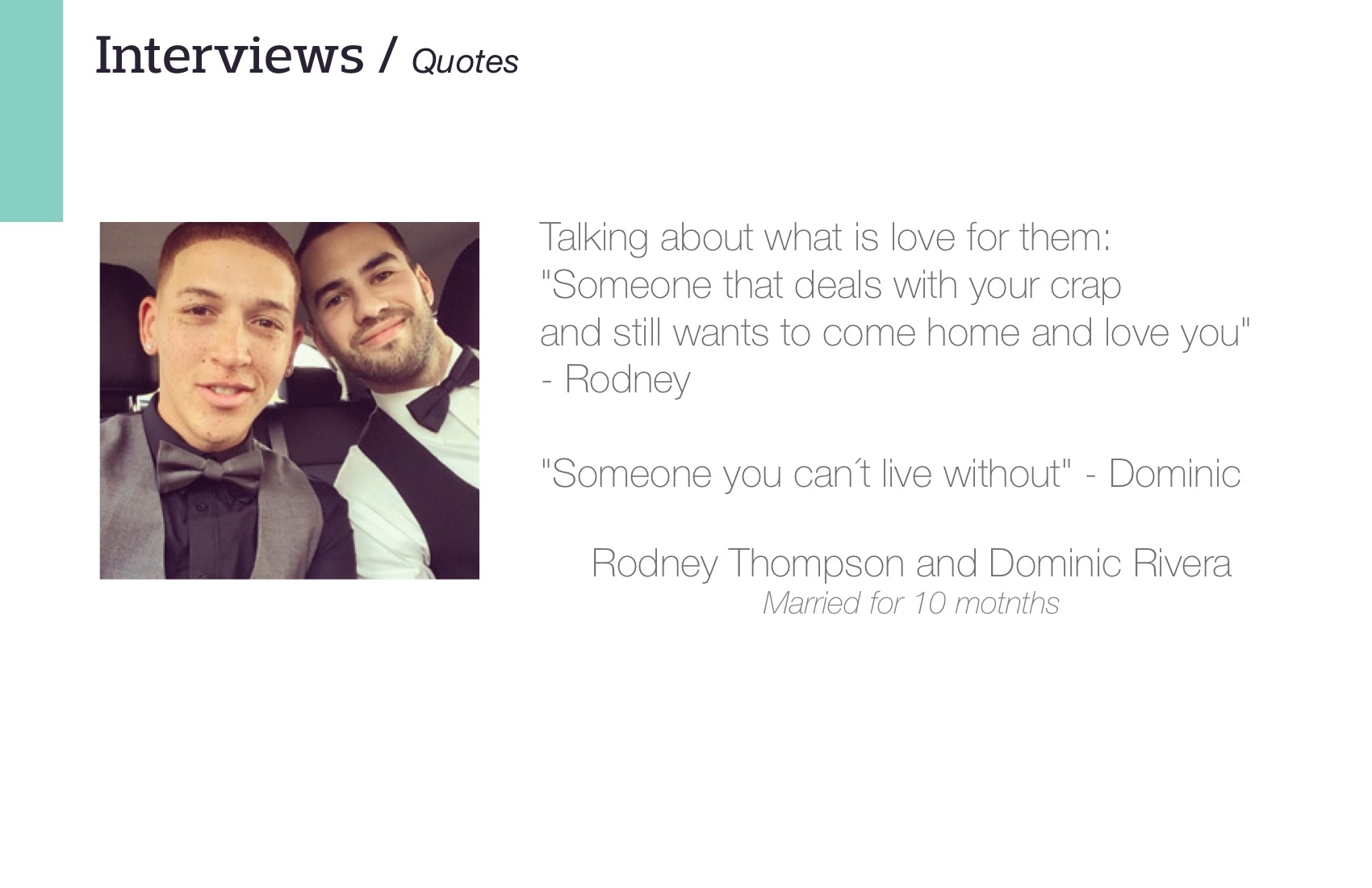



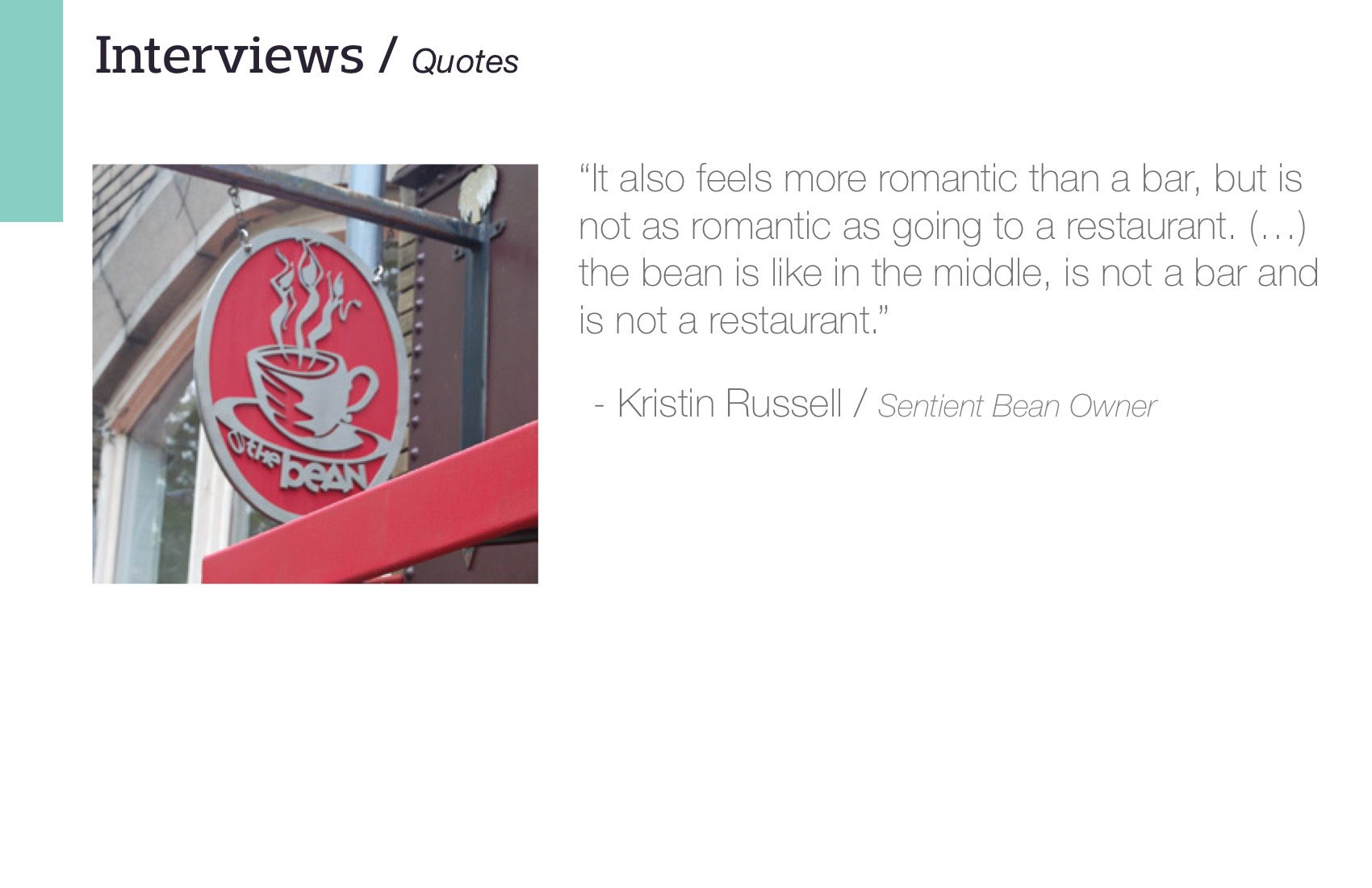

As a way to compare and contrast the input from the different interviews, we drew words, phrases and general concepts from each. Afterwards we made a map to track the similarities between the different interviews and this way have a consensus of the biggest issues around the topic. The resulting main topics were:
1. Locals perceive violence: Locals perceive violence a different city from the one filled with historical popular stories and architecture that tourists perceive.
2. City planning and slowing down: Savannah architecture and city planning encourages people to slow down while they discover the city.
3. Couples take “The Savannah Approach”: Overcoming relationships problems: “taking a Savannah approach... slowing things down.” Couples relate some slow down and patience strategies with the city.
4. Everyday romantic simple activities: Savannah offers intimacy and beautiful surroundings for simple and romantic activities like walking around and sitting next to each other
5. Exploring your senses: Music, magnolia aroma, fresh trees and warm materials as wood and historic bricks in the city, offer a delightful journey to enjoy all senses and create a romantic atmosphere.
6. Elderly vs. Young: Different ages enjoy the city in different ways. Elderly couples prefer to slowly walk around the squares during the daytime, while young couples like to hang out at night and quickly go around the squares during the daytime.
7. Artistic environment: Artistic environment and festivals influence the romantic experience in the city.
8. Tybee - a place for relaxing: Tybee Island keeps appearing as a romantic place. Couples go there to change their routine and relax.
Gathering data from primary sources allowed us to get information that reflected exactly our context and users. Secondary research is of very high value to develop primary research strategies, but becomes less valuable once those primary research data points start to appear. Secondary research is put to the test against the observations and interviews. Data might talk about specific approaches to city planning, for example, but only the user can say directly how they feel in the space.Our observations and interviews brought a lot of important topics that might not be seen at first sight in Savannah. All of them, however, are directly interrelated and don’t contradict in any way. The data gathered, although it may be subjective to the user, becomes objective data in their relationship with the space.
Mid-reserach Offering Brainstorming
As part of a creative fast exercise, we came up with 50 possible offerings that responded to the research and opportunities outlined to the date. We catalogued each of them in relation to how many of the opportunities it considered.
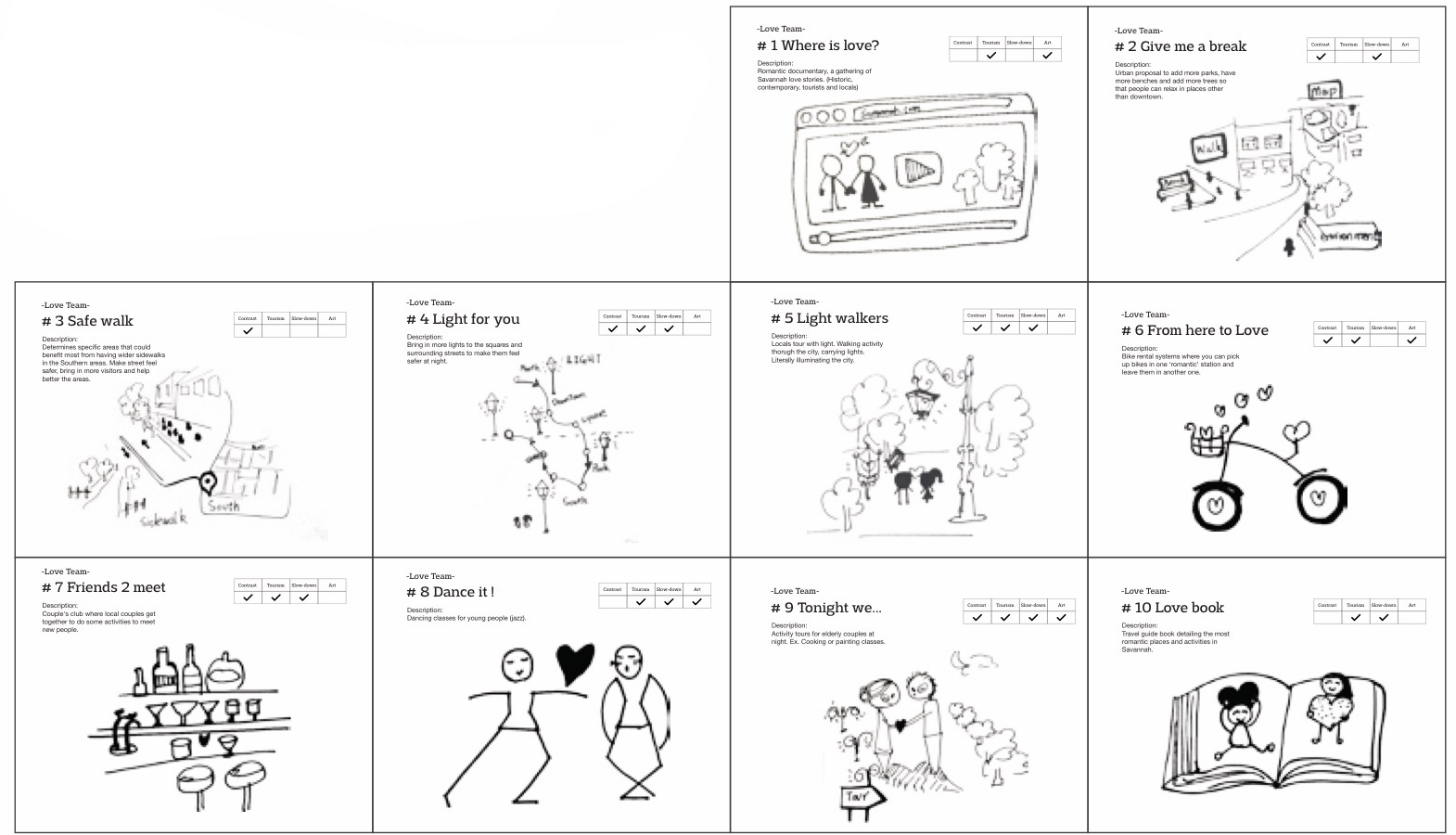
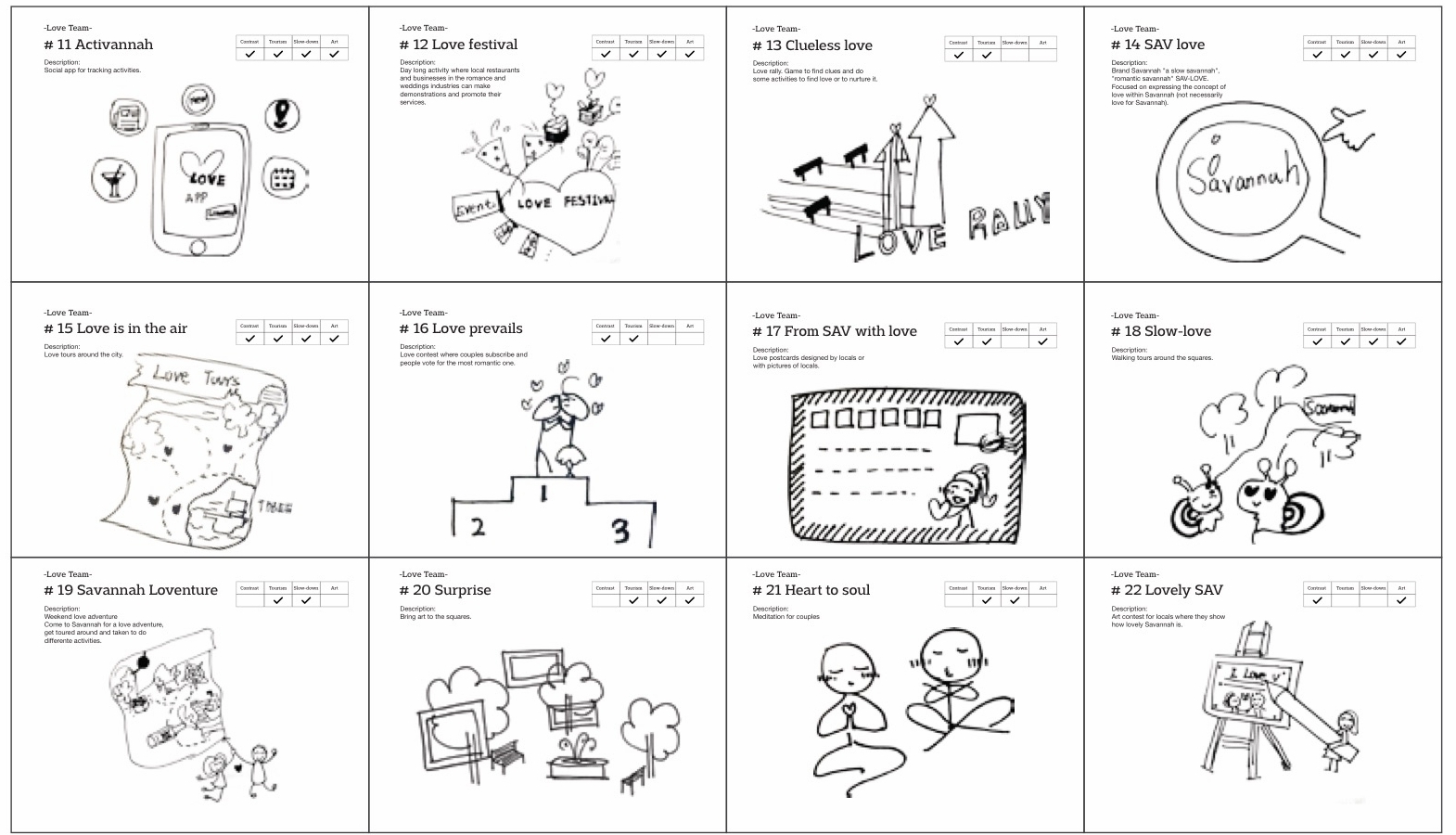

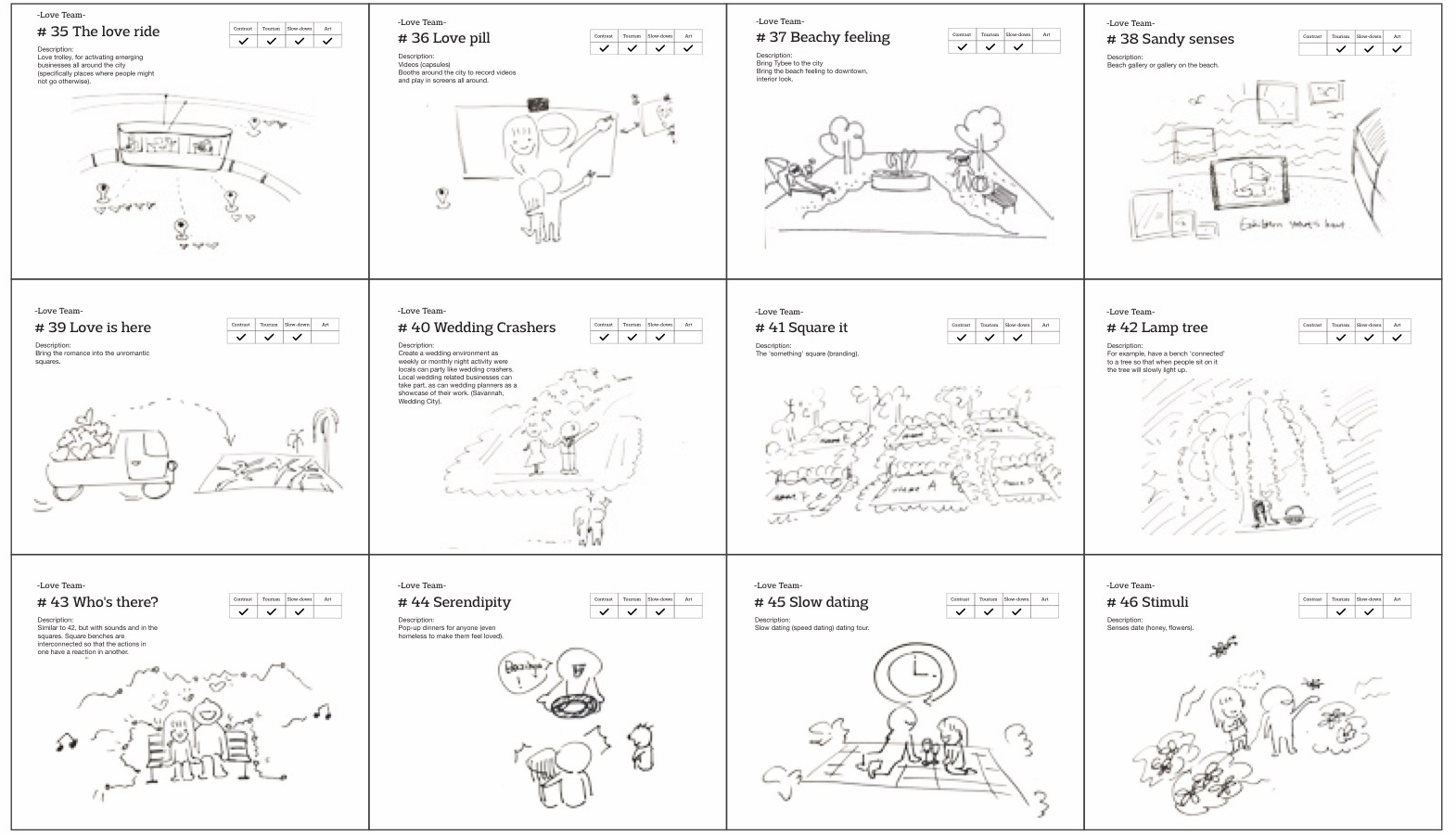

After defining 50 different possible offerings from our research, a surprise field trip was announced. We were asked to pick one of our offerings and to it in the next two hours. Our first group task was to decide which activity was feasible and still responded to our research opportunities. We decided to do the activity “Serendipity”: gifting a picnic/date to a couple in a square. We also decided to take the field trip opportunity to gather additional information. Each team member voted for their 5 favorite offerings and we chose 25 of the 50 for a Survey during the Field Trip.
Serendipity
The original concept for this activity was meant to gift a surprise date to couples around Savannah. Have a table with dinner ready and offer it to them. It created spontaneous moments for couples to create memories and sustain relationships. When faced with the challenge of doing it as fast as possible we decided to do it in the form of a surprise picnic. We set up in Chippewa Square and asked passersby to join us.
Insights: People felt uncomfortable sitting in the already set up place. It felt too much like a stage. On the other hand, when we approached people sitting down at benches and offered them the food they were more receptive. They enjoyed the activity and were grateful for our offering and for giving them the time to share something special.
Taken by surprise by the sudden field trip and urgency of designing and carrying out one of our offering, we started off a little negative and anxious. Nevertheless, we were able to divide tasks and work together for the development of the Serendipity idea. Although not our personal favorite, Serendipity appeared to be a good mix of feasible yet daring. It was interesting to have the opportunity to design as we carried out the activity. The sense of urgency helped at this point since when we put too much thought or effort into a specific action it might be more difficult to accept that it doesn’t work. In this case, we were totally open if we needed to make any variation, which we actually did. Once we changed the approach, it was great to witness the particular moment we were able to gift.
Affinity Mapping
Round 1
The first step to do our affinity mapping was to write all our data points in post-its. We went back to the beginning of our research, including our brainstorming sessions, and wrote down all the information. We came out with 504 post-its. During class, we were asked to start clustering the information without speaking to each other and rearranging it as we saw fit. We ended up with 24 clusters and later repeated the activity and got 52.
Insights: The first time we did the affinity mapping, our clusters were too big. In part, due to lack of space the clusters grouped too many topics for the mapping to be useful. After we redid the mapping with that in mind, we were able to double the amount of clusters and define new topics. The biggest topics were the ‘dark side of love’ (which included topics about violence and safety in the city), ‘relationships’, ‘ squares’ and ‘art’. We arranged all the topics within other groups of relationships such a ‘city’, ‘approach’ and ‘consideration of the negative side’.
Round 2
For our second affinity mapping we began with the same data points (post-its) that we had used for the first one. The instructions for this type of mapping, tough, were different. Clusters had a maximum of 6-8 post its, and once they were all in groups they had to be named with a blue post-it from the user’s point of view (in first person). Because some of our post-its only consisted of words, this task proved difficult to do. We went back to the interviews and wrote down quotes and comments, as phrases not keywords, and added about a hundred post its to our data points. Then we were able to continue the process.
Insights: This specific type of mapping needs more context to be effective. The voice of the user is not clearly represented through single words since they don’t provide enough context to establish relationships.
Once we finished naming the 120 blue clusters, we started to group them. We ended up creating 45 pink clusters. We proceeded to name them, again, from the voice of the user.
Cluster Analysis
Once we had the 45 pink clusters named, we went back to the 50 offerings we had prepared before. We matched the themes in the user’s thoughts as captured on the post it to all the different offerings they applied to.
Insights: Some of the ideas were captured by all of the offerings and 5 of them hadn’t been considered at all. So we decided to brainstorm different offerings for these themes. The ones that now presented those themes didn’t consider as many as the other ones and weren’t taken into the ‘next round’ of offerings.
Drawing Insights
The last step on the Affnity mapping process was to cluster the topics in the pink post-its. We ended up with 15 general themes.Once we had named the 15 general themes, we decided to analyze and draw insights from each of them that could later could be studied for solutions.
Opportunity Mind Map
We initially used the Opportunity Mind Map method and modified it to fit our specific analysis needs. We divided our green clusters into two groups: Savanah and Sustaining love. We drew connections between these concepts and finally came up with solutions for the ones that had more connections.
We clustered the solutions that we came up with. Out of the 4 clusters: 1 was related specifically to Savannah and the other 3 were more related to sustaining love. The last selection of offerings was brought in and related to the solution clusters. We combined the ones that could be combined and finally chose 5 feasible options.
Reflection:There are very clear differences between the two methods of Affinity Mapping we did. Since the second method limited the amount of post-its by cluster, it made us be more specific in our decision to cluster or not. Topics that had been previously grouped together with up to 35 data points, had to be divided into at least 6 individual groups. Through this process we discovered topics such as “I want to keep my love young” or “I came to Savannah to see him/her” that had been lost before within other clusters. The way in which we divide or name our data can have a big effect in how we analyze it. Although at first glance our post-its that contained only words made sense to us, it made it really hard to feel the user’s voice through them. It felt like a guess, more than an analysis.
Possible Offerings
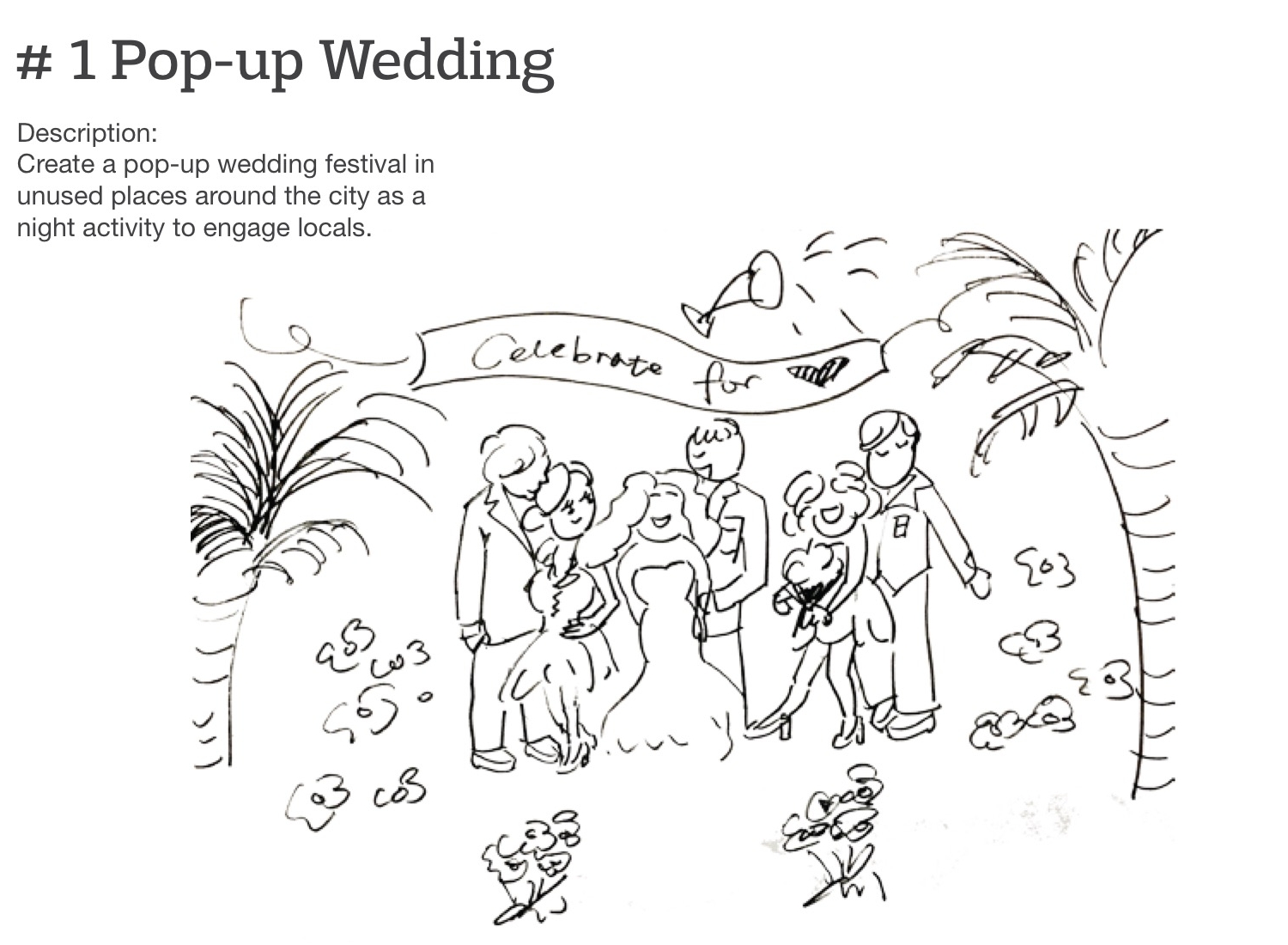





Final Offering
Light Walking Tour
Description: Candles and walking are the best friends to light up romanticism. A walking love tour around downtown Savannah with candles at night wIll lead people through fantastic romantic love stories. It will start at Johnson Square and end at Columbia Square, where everyone will get together and share a picnic.
Experience: The night when the tour took place, there was heavy rain and storm close to the city. When we knew it was safe we decided to proceed with our tour. Curtis Corthell was our tour guide and led us from Johnson Square through different stories until we finished at Historic Reynolds Square. There, and still under the rain, we presented our project and our “Guide to your Heart”. As a final detail we offered a picnic bag to everyone to take, although ideally we would have had it together in the square.
Insights: One of the most recurrent topics in our primary research was the feeling of loneliness and insecurity during Savannah’s night, and how this determined the kind of activities and places that people accessed, letting apart the enjoyment of public spaces like squares. Another remarkable finding, was how often couples found wandering around the city one of the most romantic activities to do in Savannah. That is how we decided to create an activity that provided a safe atmosphere overcoming the loneliness of darkness in the city by lighting candles and walking in groups around public spaces, while discovering romantic stories, venues and people in Savannah.
A Guide for your heart in Savannah
A comprehensive guide for everyone’s heart in Savannah. It includes maps and activities like walking tours for recovering from breakups, or slow dating plans to meet new people, that have been tailored as much for the user as for the city itself. It is directed to locals and tourists.

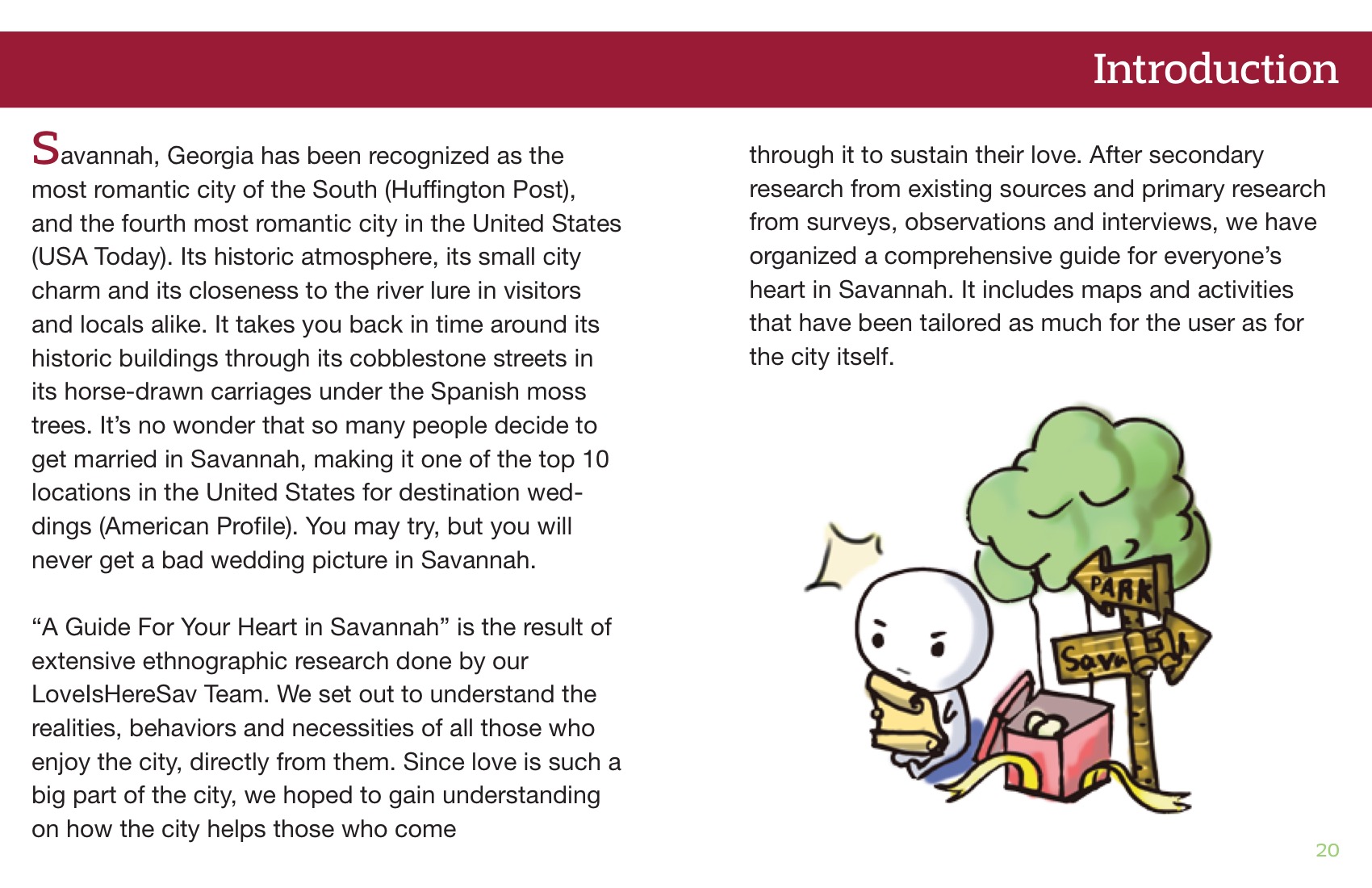




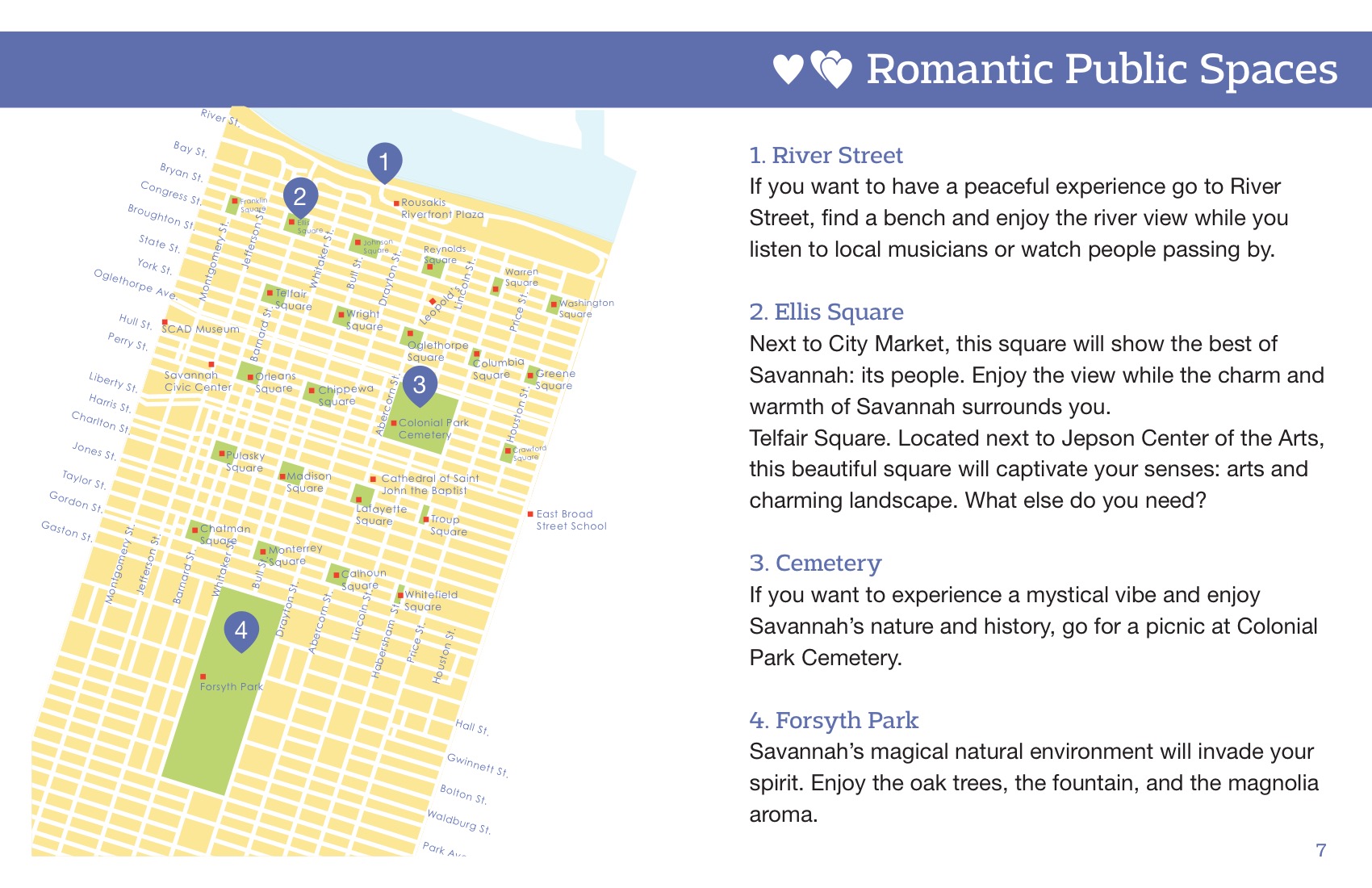

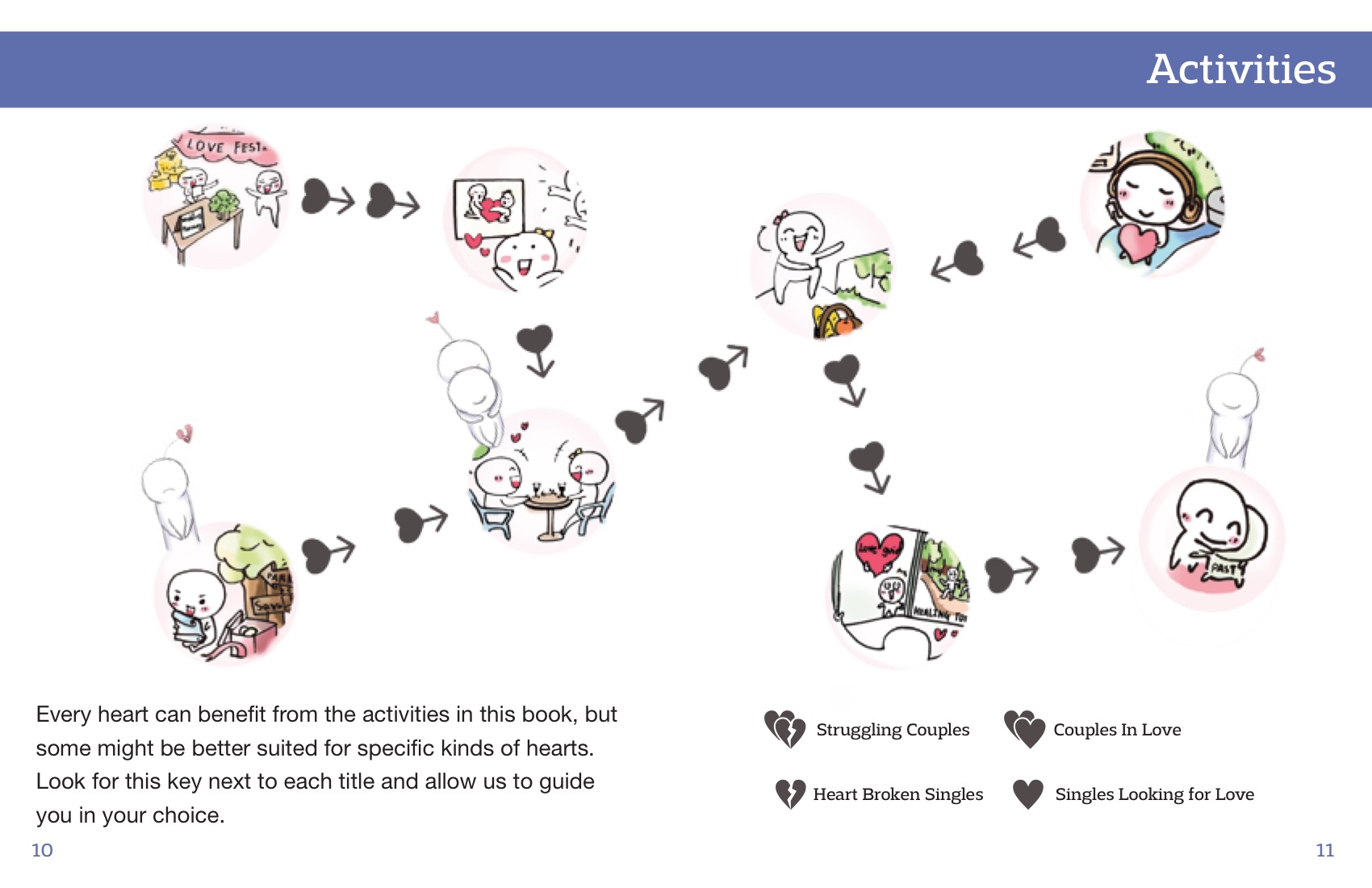









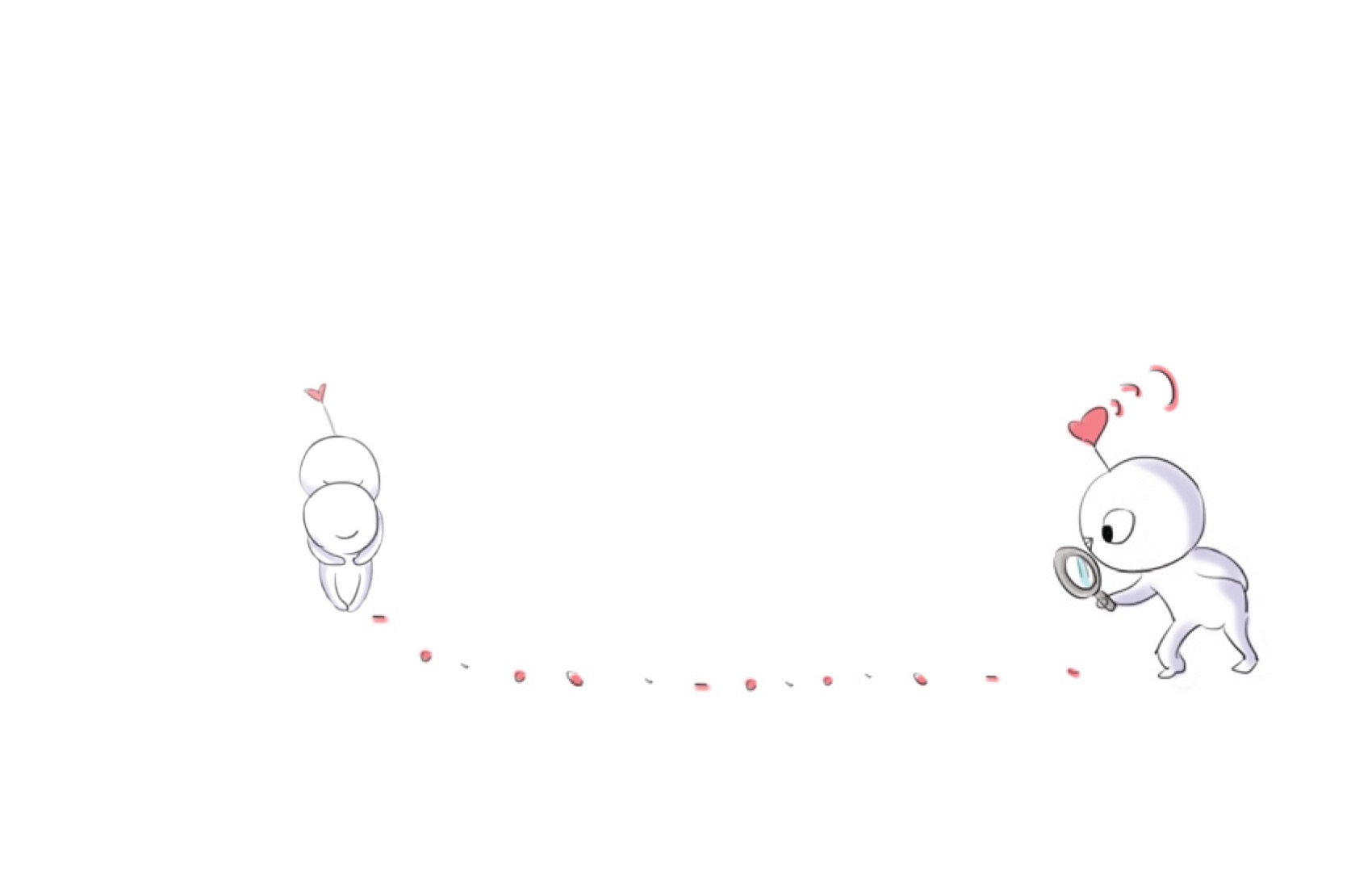
Collaboration
After we finished the course, we had the opportunity to share our research with a Graphic Design MFA student at SCAD. She used our research, findings and prototypes as inspiration for her own final project. She developed a logo, visual identity and interface for an app inspired by our Guidebook. The following is her work:

































